Entrepreneurship and Design Thinking: A Reflective Report Analysis
VerifiedAdded on 2020/03/15
|10
|2928
|34
Report
AI Summary
This report is a reflective analysis of a student's experiences during a unit on entrepreneurship and design thinking. The student explores the concepts of reflective writing, blogs, entrepreneurship, and design thinking. The report details the application of design thinking to solve a real-world problem: tracking grocery levels. The student identifies the problem through community interaction, develops a questionnaire, and identifies the challenge of managing groceries. The report then follows the design thinking process: problem definition, research, ideation, prototyping, implementation, and learning. The solution is a grocery tracking application, and the report discusses the business model, user feedback, and the application's ability to learn user habits. The report concludes with reflections on the entrepreneurship journey.
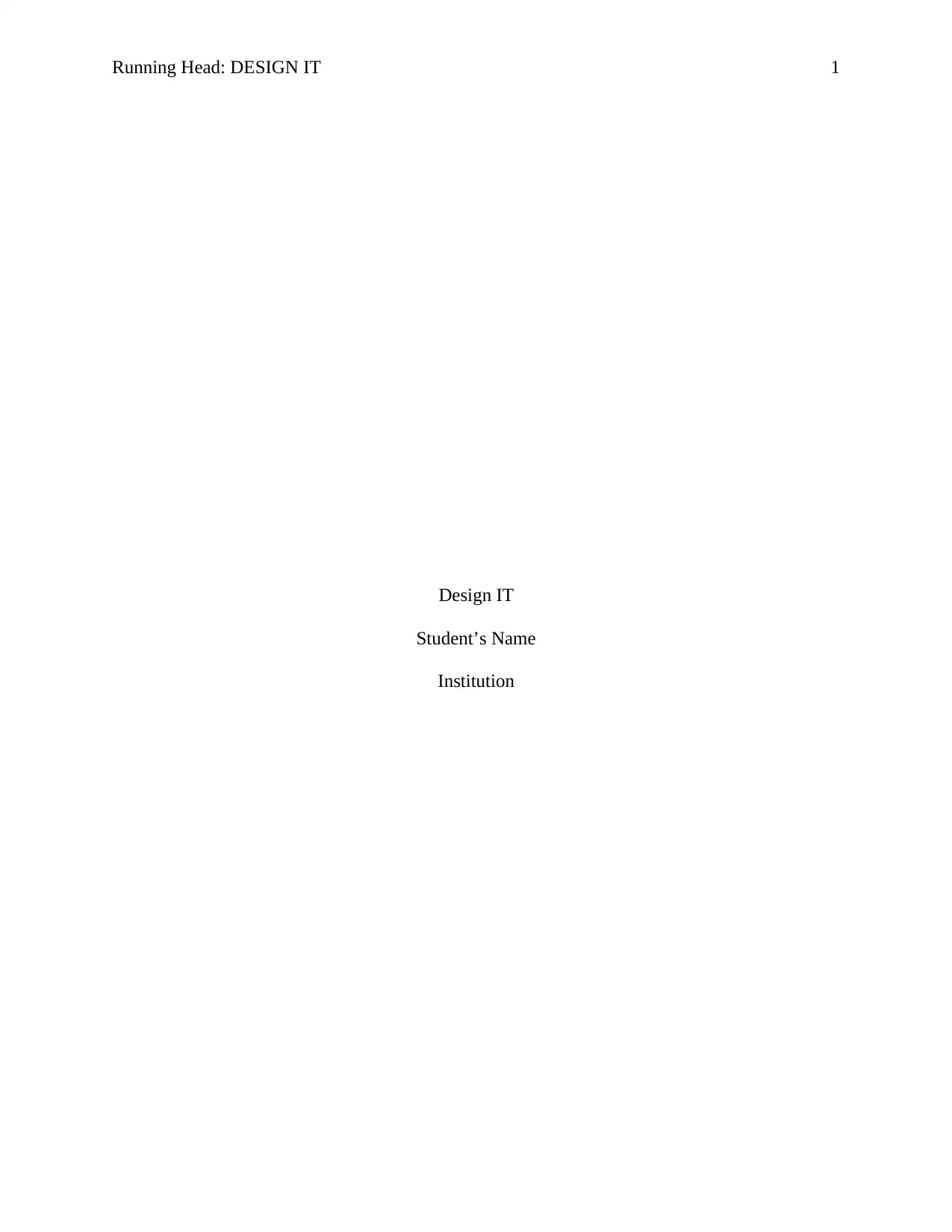
Running Head: DESIGN IT 1
Design IT
Student’s Name
Institution
Design IT
Student’s Name
Institution
Paraphrase This Document
Need a fresh take? Get an instant paraphrase of this document with our AI Paraphraser
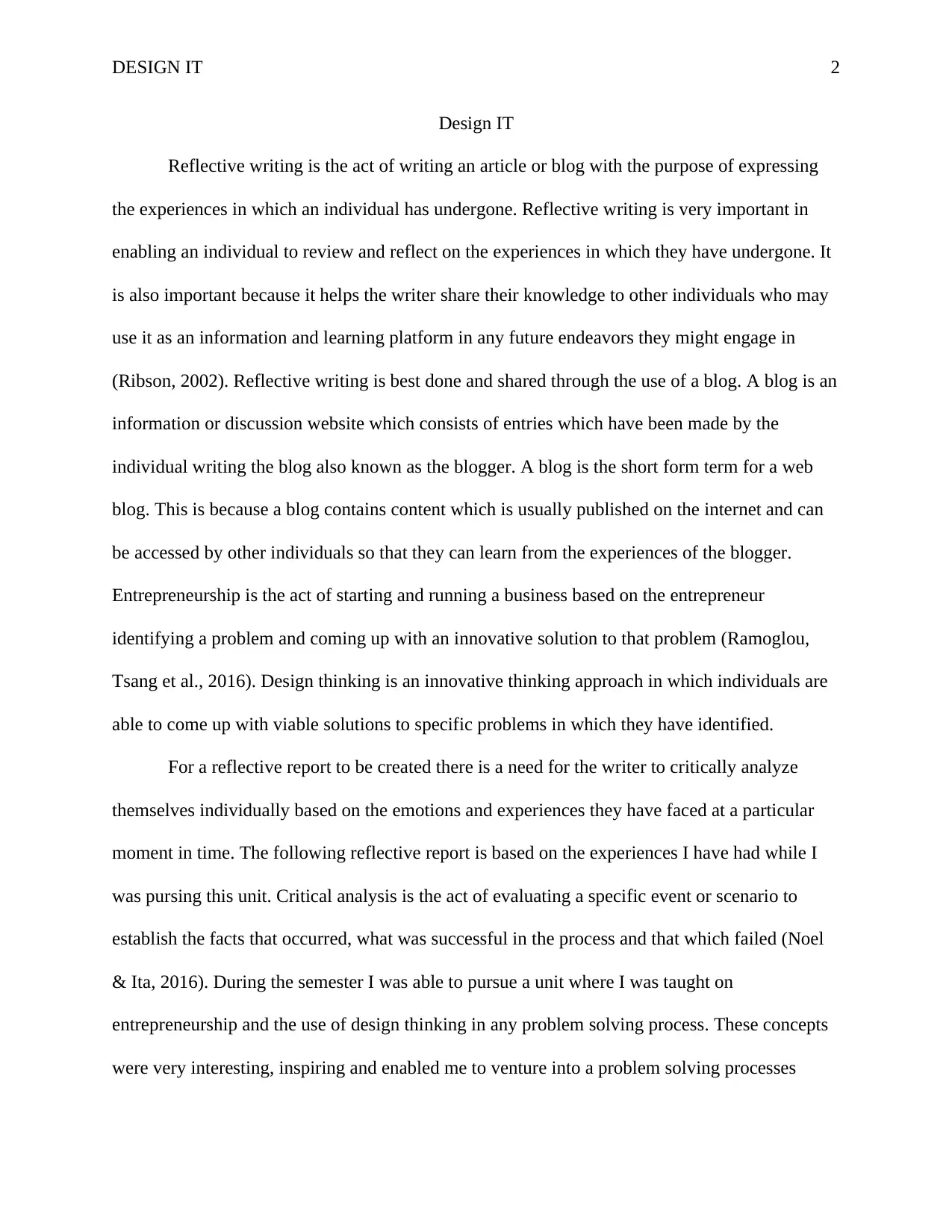
DESIGN IT 2
Design IT
Reflective writing is the act of writing an article or blog with the purpose of expressing
the experiences in which an individual has undergone. Reflective writing is very important in
enabling an individual to review and reflect on the experiences in which they have undergone. It
is also important because it helps the writer share their knowledge to other individuals who may
use it as an information and learning platform in any future endeavors they might engage in
(Ribson, 2002). Reflective writing is best done and shared through the use of a blog. A blog is an
information or discussion website which consists of entries which have been made by the
individual writing the blog also known as the blogger. A blog is the short form term for a web
blog. This is because a blog contains content which is usually published on the internet and can
be accessed by other individuals so that they can learn from the experiences of the blogger.
Entrepreneurship is the act of starting and running a business based on the entrepreneur
identifying a problem and coming up with an innovative solution to that problem (Ramoglou,
Tsang et al., 2016). Design thinking is an innovative thinking approach in which individuals are
able to come up with viable solutions to specific problems in which they have identified.
For a reflective report to be created there is a need for the writer to critically analyze
themselves individually based on the emotions and experiences they have faced at a particular
moment in time. The following reflective report is based on the experiences I have had while I
was pursing this unit. Critical analysis is the act of evaluating a specific event or scenario to
establish the facts that occurred, what was successful in the process and that which failed (Noel
& Ita, 2016). During the semester I was able to pursue a unit where I was taught on
entrepreneurship and the use of design thinking in any problem solving process. These concepts
were very interesting, inspiring and enabled me to venture into a problem solving processes
Design IT
Reflective writing is the act of writing an article or blog with the purpose of expressing
the experiences in which an individual has undergone. Reflective writing is very important in
enabling an individual to review and reflect on the experiences in which they have undergone. It
is also important because it helps the writer share their knowledge to other individuals who may
use it as an information and learning platform in any future endeavors they might engage in
(Ribson, 2002). Reflective writing is best done and shared through the use of a blog. A blog is an
information or discussion website which consists of entries which have been made by the
individual writing the blog also known as the blogger. A blog is the short form term for a web
blog. This is because a blog contains content which is usually published on the internet and can
be accessed by other individuals so that they can learn from the experiences of the blogger.
Entrepreneurship is the act of starting and running a business based on the entrepreneur
identifying a problem and coming up with an innovative solution to that problem (Ramoglou,
Tsang et al., 2016). Design thinking is an innovative thinking approach in which individuals are
able to come up with viable solutions to specific problems in which they have identified.
For a reflective report to be created there is a need for the writer to critically analyze
themselves individually based on the emotions and experiences they have faced at a particular
moment in time. The following reflective report is based on the experiences I have had while I
was pursing this unit. Critical analysis is the act of evaluating a specific event or scenario to
establish the facts that occurred, what was successful in the process and that which failed (Noel
& Ita, 2016). During the semester I was able to pursue a unit where I was taught on
entrepreneurship and the use of design thinking in any problem solving process. These concepts
were very interesting, inspiring and enabled me to venture into a problem solving processes
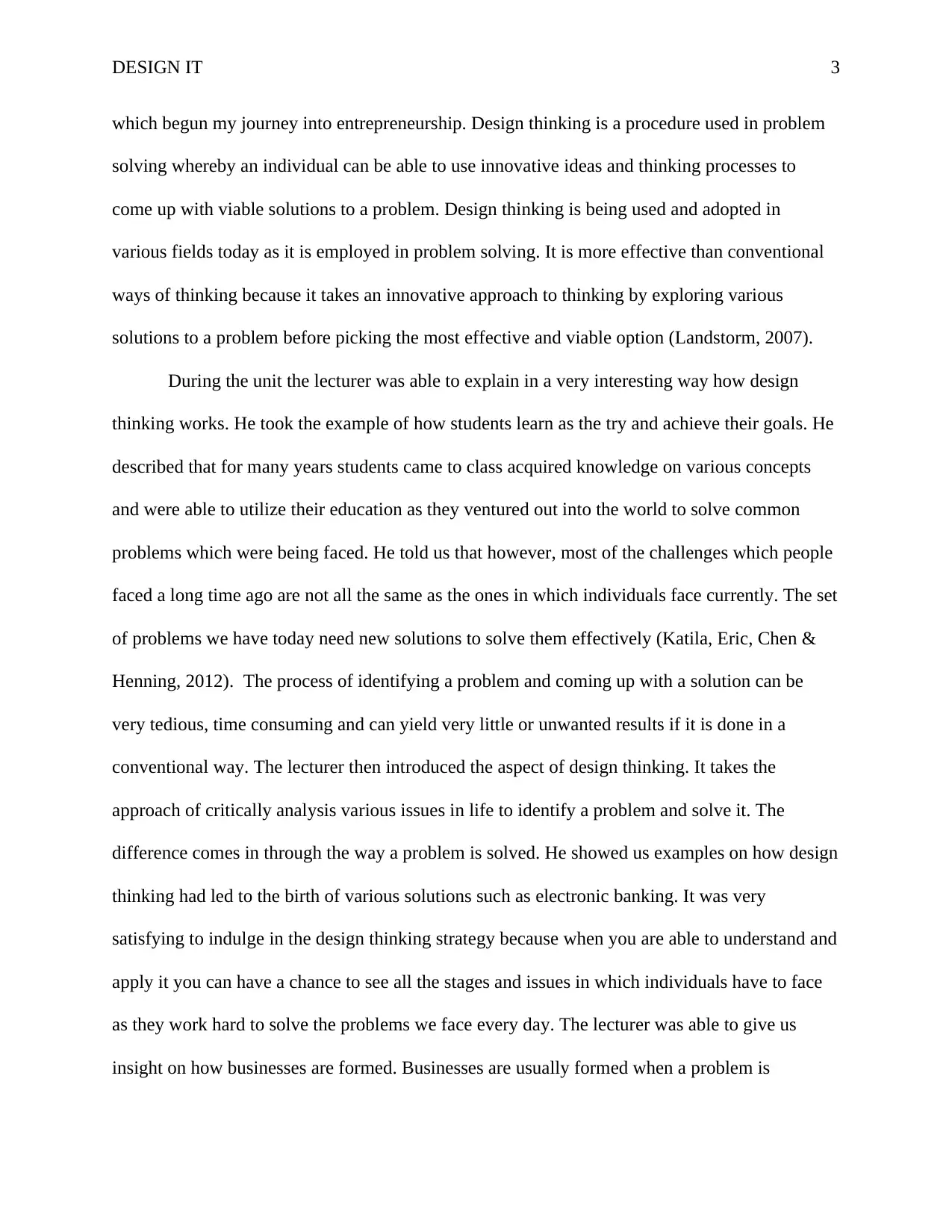
DESIGN IT 3
which begun my journey into entrepreneurship. Design thinking is a procedure used in problem
solving whereby an individual can be able to use innovative ideas and thinking processes to
come up with viable solutions to a problem. Design thinking is being used and adopted in
various fields today as it is employed in problem solving. It is more effective than conventional
ways of thinking because it takes an innovative approach to thinking by exploring various
solutions to a problem before picking the most effective and viable option (Landstorm, 2007).
During the unit the lecturer was able to explain in a very interesting way how design
thinking works. He took the example of how students learn as the try and achieve their goals. He
described that for many years students came to class acquired knowledge on various concepts
and were able to utilize their education as they ventured out into the world to solve common
problems which were being faced. He told us that however, most of the challenges which people
faced a long time ago are not all the same as the ones in which individuals face currently. The set
of problems we have today need new solutions to solve them effectively (Katila, Eric, Chen &
Henning, 2012). The process of identifying a problem and coming up with a solution can be
very tedious, time consuming and can yield very little or unwanted results if it is done in a
conventional way. The lecturer then introduced the aspect of design thinking. It takes the
approach of critically analysis various issues in life to identify a problem and solve it. The
difference comes in through the way a problem is solved. He showed us examples on how design
thinking had led to the birth of various solutions such as electronic banking. It was very
satisfying to indulge in the design thinking strategy because when you are able to understand and
apply it you can have a chance to see all the stages and issues in which individuals have to face
as they work hard to solve the problems we face every day. The lecturer was able to give us
insight on how businesses are formed. Businesses are usually formed when a problem is
which begun my journey into entrepreneurship. Design thinking is a procedure used in problem
solving whereby an individual can be able to use innovative ideas and thinking processes to
come up with viable solutions to a problem. Design thinking is being used and adopted in
various fields today as it is employed in problem solving. It is more effective than conventional
ways of thinking because it takes an innovative approach to thinking by exploring various
solutions to a problem before picking the most effective and viable option (Landstorm, 2007).
During the unit the lecturer was able to explain in a very interesting way how design
thinking works. He took the example of how students learn as the try and achieve their goals. He
described that for many years students came to class acquired knowledge on various concepts
and were able to utilize their education as they ventured out into the world to solve common
problems which were being faced. He told us that however, most of the challenges which people
faced a long time ago are not all the same as the ones in which individuals face currently. The set
of problems we have today need new solutions to solve them effectively (Katila, Eric, Chen &
Henning, 2012). The process of identifying a problem and coming up with a solution can be
very tedious, time consuming and can yield very little or unwanted results if it is done in a
conventional way. The lecturer then introduced the aspect of design thinking. It takes the
approach of critically analysis various issues in life to identify a problem and solve it. The
difference comes in through the way a problem is solved. He showed us examples on how design
thinking had led to the birth of various solutions such as electronic banking. It was very
satisfying to indulge in the design thinking strategy because when you are able to understand and
apply it you can have a chance to see all the stages and issues in which individuals have to face
as they work hard to solve the problems we face every day. The lecturer was able to give us
insight on how businesses are formed. Businesses are usually formed when a problem is
⊘ This is a preview!⊘
Do you want full access?
Subscribe today to unlock all pages.

Trusted by 1+ million students worldwide
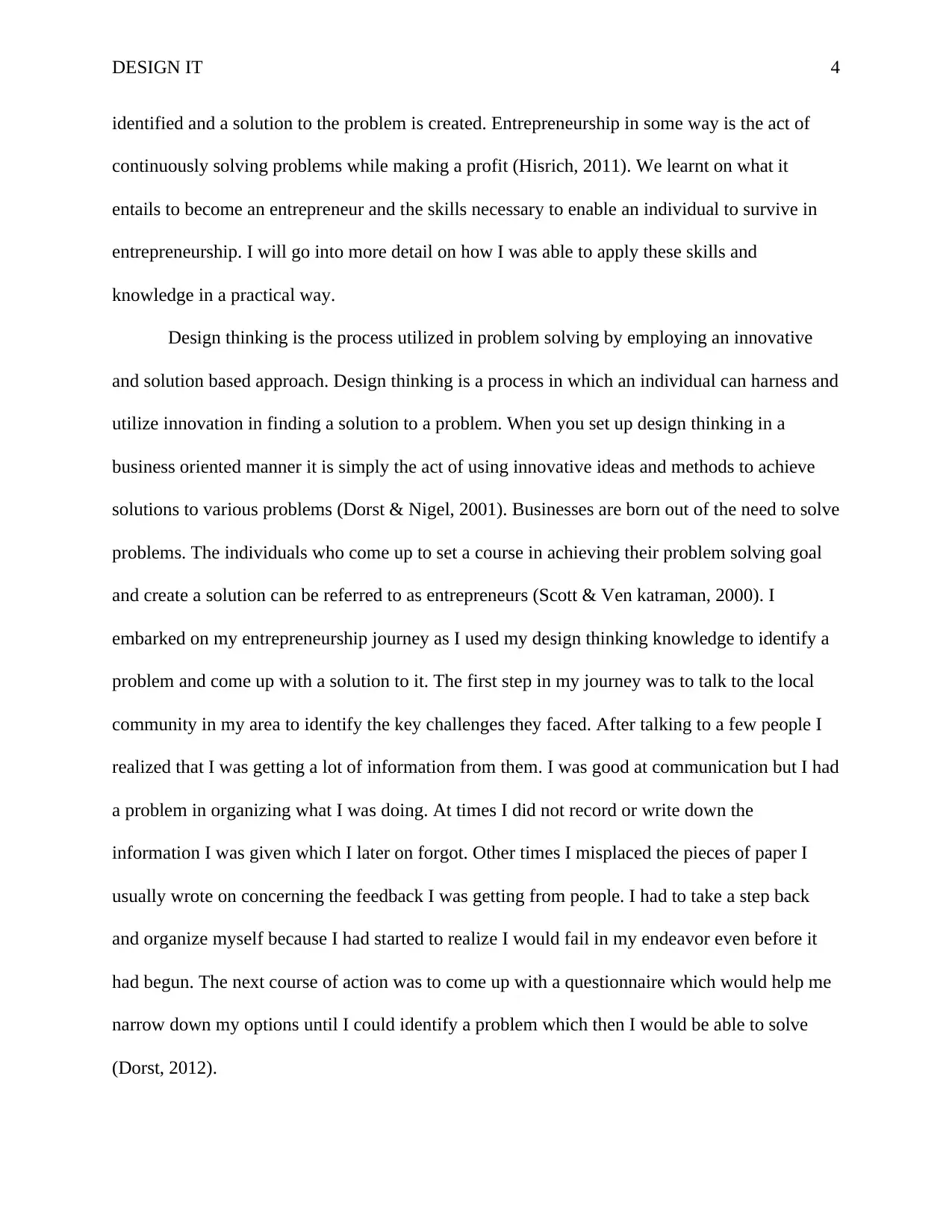
DESIGN IT 4
identified and a solution to the problem is created. Entrepreneurship in some way is the act of
continuously solving problems while making a profit (Hisrich, 2011). We learnt on what it
entails to become an entrepreneur and the skills necessary to enable an individual to survive in
entrepreneurship. I will go into more detail on how I was able to apply these skills and
knowledge in a practical way.
Design thinking is the process utilized in problem solving by employing an innovative
and solution based approach. Design thinking is a process in which an individual can harness and
utilize innovation in finding a solution to a problem. When you set up design thinking in a
business oriented manner it is simply the act of using innovative ideas and methods to achieve
solutions to various problems (Dorst & Nigel, 2001). Businesses are born out of the need to solve
problems. The individuals who come up to set a course in achieving their problem solving goal
and create a solution can be referred to as entrepreneurs (Scott & Ven katraman, 2000). I
embarked on my entrepreneurship journey as I used my design thinking knowledge to identify a
problem and come up with a solution to it. The first step in my journey was to talk to the local
community in my area to identify the key challenges they faced. After talking to a few people I
realized that I was getting a lot of information from them. I was good at communication but I had
a problem in organizing what I was doing. At times I did not record or write down the
information I was given which I later on forgot. Other times I misplaced the pieces of paper I
usually wrote on concerning the feedback I was getting from people. I had to take a step back
and organize myself because I had started to realize I would fail in my endeavor even before it
had begun. The next course of action was to come up with a questionnaire which would help me
narrow down my options until I could identify a problem which then I would be able to solve
(Dorst, 2012).
identified and a solution to the problem is created. Entrepreneurship in some way is the act of
continuously solving problems while making a profit (Hisrich, 2011). We learnt on what it
entails to become an entrepreneur and the skills necessary to enable an individual to survive in
entrepreneurship. I will go into more detail on how I was able to apply these skills and
knowledge in a practical way.
Design thinking is the process utilized in problem solving by employing an innovative
and solution based approach. Design thinking is a process in which an individual can harness and
utilize innovation in finding a solution to a problem. When you set up design thinking in a
business oriented manner it is simply the act of using innovative ideas and methods to achieve
solutions to various problems (Dorst & Nigel, 2001). Businesses are born out of the need to solve
problems. The individuals who come up to set a course in achieving their problem solving goal
and create a solution can be referred to as entrepreneurs (Scott & Ven katraman, 2000). I
embarked on my entrepreneurship journey as I used my design thinking knowledge to identify a
problem and come up with a solution to it. The first step in my journey was to talk to the local
community in my area to identify the key challenges they faced. After talking to a few people I
realized that I was getting a lot of information from them. I was good at communication but I had
a problem in organizing what I was doing. At times I did not record or write down the
information I was given which I later on forgot. Other times I misplaced the pieces of paper I
usually wrote on concerning the feedback I was getting from people. I had to take a step back
and organize myself because I had started to realize I would fail in my endeavor even before it
had begun. The next course of action was to come up with a questionnaire which would help me
narrow down my options until I could identify a problem which then I would be able to solve
(Dorst, 2012).
Paraphrase This Document
Need a fresh take? Get an instant paraphrase of this document with our AI Paraphraser
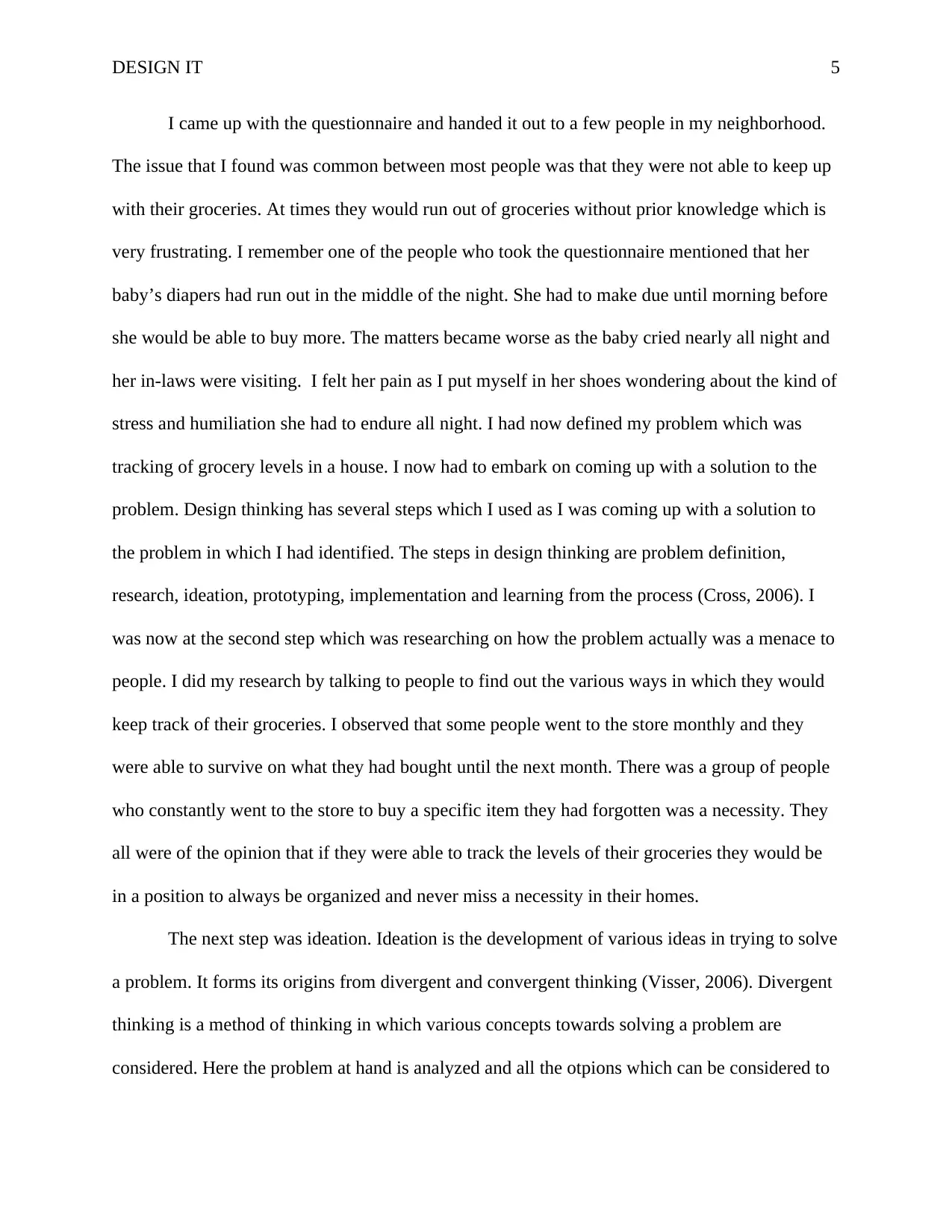
DESIGN IT 5
I came up with the questionnaire and handed it out to a few people in my neighborhood.
The issue that I found was common between most people was that they were not able to keep up
with their groceries. At times they would run out of groceries without prior knowledge which is
very frustrating. I remember one of the people who took the questionnaire mentioned that her
baby’s diapers had run out in the middle of the night. She had to make due until morning before
she would be able to buy more. The matters became worse as the baby cried nearly all night and
her in-laws were visiting. I felt her pain as I put myself in her shoes wondering about the kind of
stress and humiliation she had to endure all night. I had now defined my problem which was
tracking of grocery levels in a house. I now had to embark on coming up with a solution to the
problem. Design thinking has several steps which I used as I was coming up with a solution to
the problem in which I had identified. The steps in design thinking are problem definition,
research, ideation, prototyping, implementation and learning from the process (Cross, 2006). I
was now at the second step which was researching on how the problem actually was a menace to
people. I did my research by talking to people to find out the various ways in which they would
keep track of their groceries. I observed that some people went to the store monthly and they
were able to survive on what they had bought until the next month. There was a group of people
who constantly went to the store to buy a specific item they had forgotten was a necessity. They
all were of the opinion that if they were able to track the levels of their groceries they would be
in a position to always be organized and never miss a necessity in their homes.
The next step was ideation. Ideation is the development of various ideas in trying to solve
a problem. It forms its origins from divergent and convergent thinking (Visser, 2006). Divergent
thinking is a method of thinking in which various concepts towards solving a problem are
considered. Here the problem at hand is analyzed and all the otpions which can be considered to
I came up with the questionnaire and handed it out to a few people in my neighborhood.
The issue that I found was common between most people was that they were not able to keep up
with their groceries. At times they would run out of groceries without prior knowledge which is
very frustrating. I remember one of the people who took the questionnaire mentioned that her
baby’s diapers had run out in the middle of the night. She had to make due until morning before
she would be able to buy more. The matters became worse as the baby cried nearly all night and
her in-laws were visiting. I felt her pain as I put myself in her shoes wondering about the kind of
stress and humiliation she had to endure all night. I had now defined my problem which was
tracking of grocery levels in a house. I now had to embark on coming up with a solution to the
problem. Design thinking has several steps which I used as I was coming up with a solution to
the problem in which I had identified. The steps in design thinking are problem definition,
research, ideation, prototyping, implementation and learning from the process (Cross, 2006). I
was now at the second step which was researching on how the problem actually was a menace to
people. I did my research by talking to people to find out the various ways in which they would
keep track of their groceries. I observed that some people went to the store monthly and they
were able to survive on what they had bought until the next month. There was a group of people
who constantly went to the store to buy a specific item they had forgotten was a necessity. They
all were of the opinion that if they were able to track the levels of their groceries they would be
in a position to always be organized and never miss a necessity in their homes.
The next step was ideation. Ideation is the development of various ideas in trying to solve
a problem. It forms its origins from divergent and convergent thinking (Visser, 2006). Divergent
thinking is a method of thinking in which various concepts towards solving a problem are
considered. Here the problem at hand is analyzed and all the otpions which can be considered to
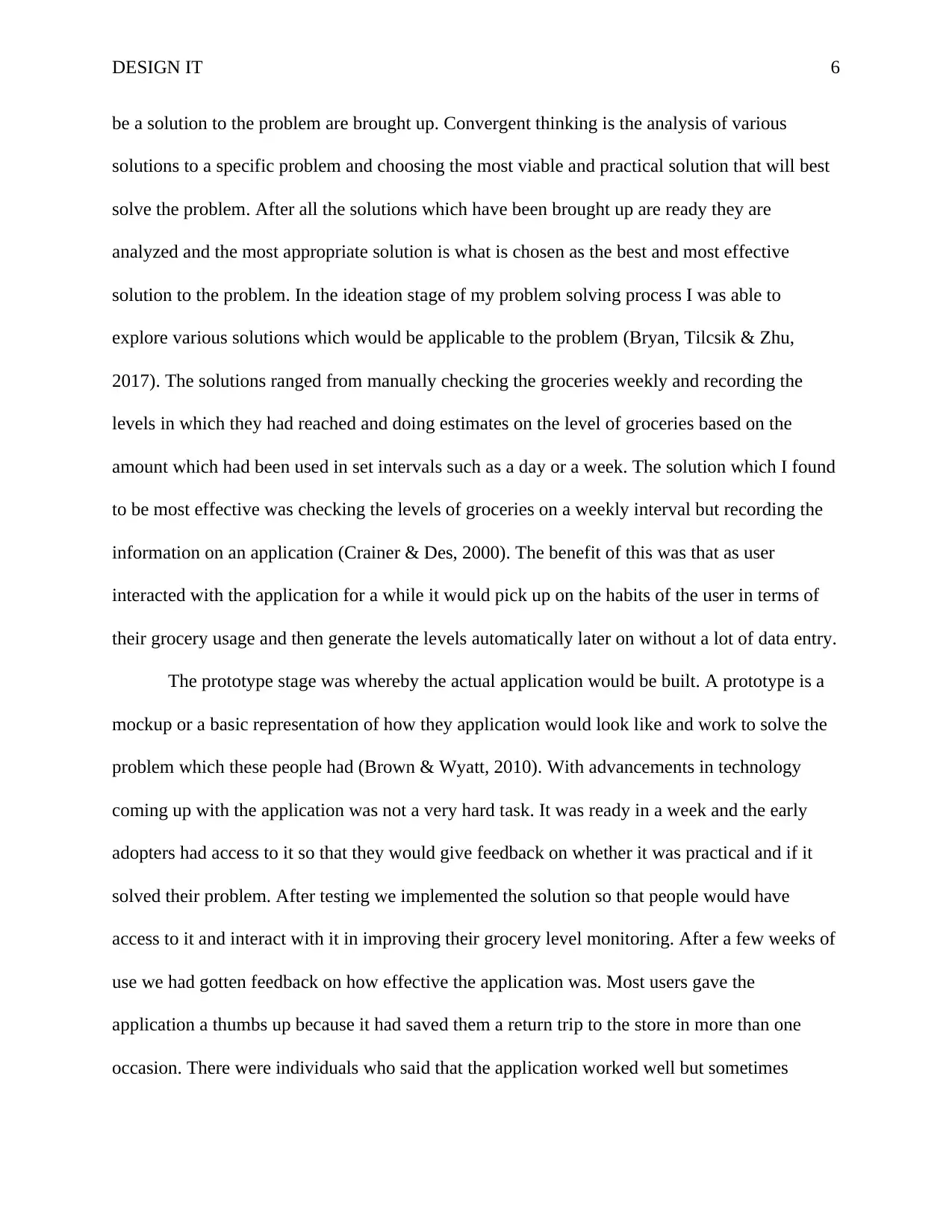
DESIGN IT 6
be a solution to the problem are brought up. Convergent thinking is the analysis of various
solutions to a specific problem and choosing the most viable and practical solution that will best
solve the problem. After all the solutions which have been brought up are ready they are
analyzed and the most appropriate solution is what is chosen as the best and most effective
solution to the problem. In the ideation stage of my problem solving process I was able to
explore various solutions which would be applicable to the problem (Bryan, Tilcsik & Zhu,
2017). The solutions ranged from manually checking the groceries weekly and recording the
levels in which they had reached and doing estimates on the level of groceries based on the
amount which had been used in set intervals such as a day or a week. The solution which I found
to be most effective was checking the levels of groceries on a weekly interval but recording the
information on an application (Crainer & Des, 2000). The benefit of this was that as user
interacted with the application for a while it would pick up on the habits of the user in terms of
their grocery usage and then generate the levels automatically later on without a lot of data entry.
The prototype stage was whereby the actual application would be built. A prototype is a
mockup or a basic representation of how they application would look like and work to solve the
problem which these people had (Brown & Wyatt, 2010). With advancements in technology
coming up with the application was not a very hard task. It was ready in a week and the early
adopters had access to it so that they would give feedback on whether it was practical and if it
solved their problem. After testing we implemented the solution so that people would have
access to it and interact with it in improving their grocery level monitoring. After a few weeks of
use we had gotten feedback on how effective the application was. Most users gave the
application a thumbs up because it had saved them a return trip to the store in more than one
occasion. There were individuals who said that the application worked well but sometimes
be a solution to the problem are brought up. Convergent thinking is the analysis of various
solutions to a specific problem and choosing the most viable and practical solution that will best
solve the problem. After all the solutions which have been brought up are ready they are
analyzed and the most appropriate solution is what is chosen as the best and most effective
solution to the problem. In the ideation stage of my problem solving process I was able to
explore various solutions which would be applicable to the problem (Bryan, Tilcsik & Zhu,
2017). The solutions ranged from manually checking the groceries weekly and recording the
levels in which they had reached and doing estimates on the level of groceries based on the
amount which had been used in set intervals such as a day or a week. The solution which I found
to be most effective was checking the levels of groceries on a weekly interval but recording the
information on an application (Crainer & Des, 2000). The benefit of this was that as user
interacted with the application for a while it would pick up on the habits of the user in terms of
their grocery usage and then generate the levels automatically later on without a lot of data entry.
The prototype stage was whereby the actual application would be built. A prototype is a
mockup or a basic representation of how they application would look like and work to solve the
problem which these people had (Brown & Wyatt, 2010). With advancements in technology
coming up with the application was not a very hard task. It was ready in a week and the early
adopters had access to it so that they would give feedback on whether it was practical and if it
solved their problem. After testing we implemented the solution so that people would have
access to it and interact with it in improving their grocery level monitoring. After a few weeks of
use we had gotten feedback on how effective the application was. Most users gave the
application a thumbs up because it had saved them a return trip to the store in more than one
occasion. There were individuals who said that the application worked well but sometimes
⊘ This is a preview!⊘
Do you want full access?
Subscribe today to unlock all pages.

Trusted by 1+ million students worldwide
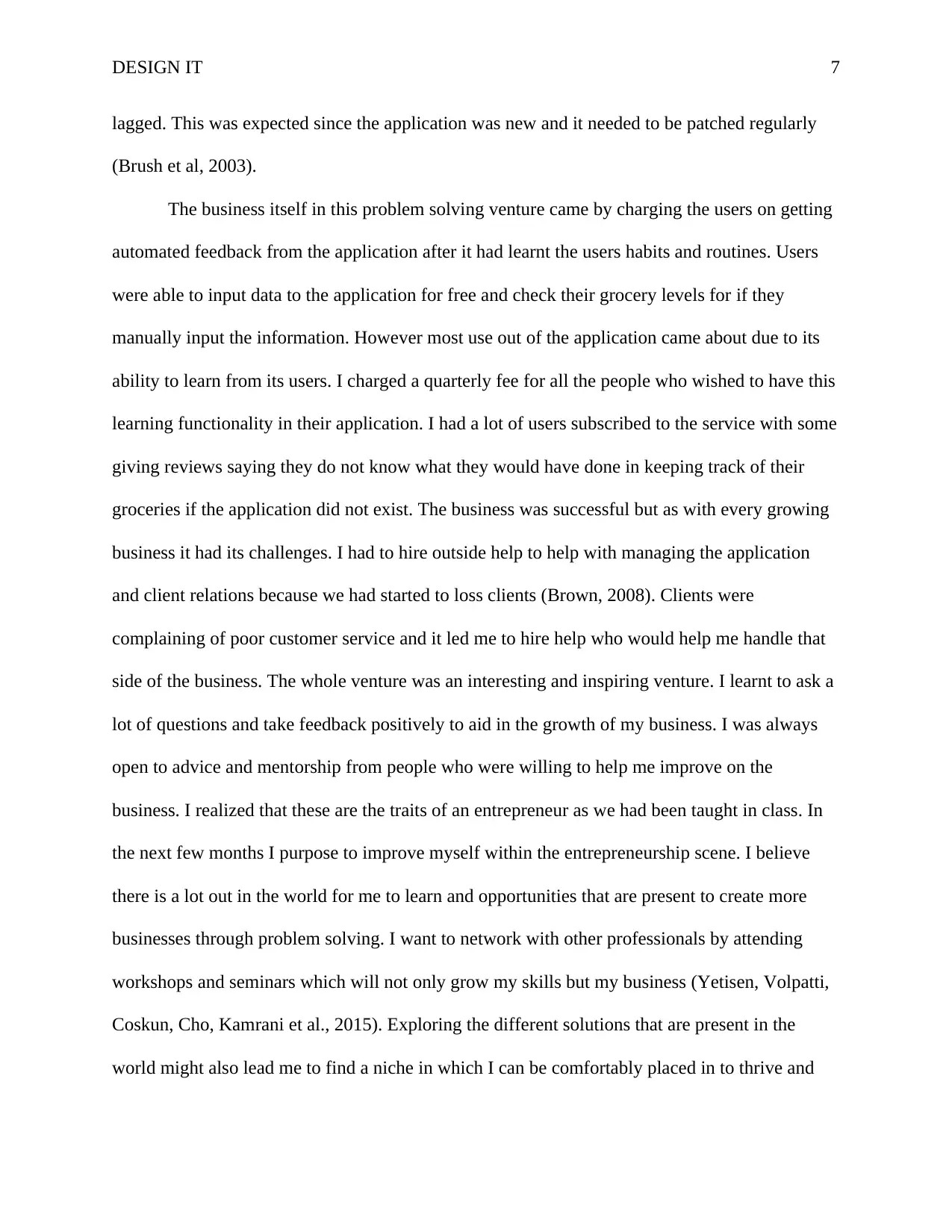
DESIGN IT 7
lagged. This was expected since the application was new and it needed to be patched regularly
(Brush et al, 2003).
The business itself in this problem solving venture came by charging the users on getting
automated feedback from the application after it had learnt the users habits and routines. Users
were able to input data to the application for free and check their grocery levels for if they
manually input the information. However most use out of the application came about due to its
ability to learn from its users. I charged a quarterly fee for all the people who wished to have this
learning functionality in their application. I had a lot of users subscribed to the service with some
giving reviews saying they do not know what they would have done in keeping track of their
groceries if the application did not exist. The business was successful but as with every growing
business it had its challenges. I had to hire outside help to help with managing the application
and client relations because we had started to loss clients (Brown, 2008). Clients were
complaining of poor customer service and it led me to hire help who would help me handle that
side of the business. The whole venture was an interesting and inspiring venture. I learnt to ask a
lot of questions and take feedback positively to aid in the growth of my business. I was always
open to advice and mentorship from people who were willing to help me improve on the
business. I realized that these are the traits of an entrepreneur as we had been taught in class. In
the next few months I purpose to improve myself within the entrepreneurship scene. I believe
there is a lot out in the world for me to learn and opportunities that are present to create more
businesses through problem solving. I want to network with other professionals by attending
workshops and seminars which will not only grow my skills but my business (Yetisen, Volpatti,
Coskun, Cho, Kamrani et al., 2015). Exploring the different solutions that are present in the
world might also lead me to find a niche in which I can be comfortably placed in to thrive and
lagged. This was expected since the application was new and it needed to be patched regularly
(Brush et al, 2003).
The business itself in this problem solving venture came by charging the users on getting
automated feedback from the application after it had learnt the users habits and routines. Users
were able to input data to the application for free and check their grocery levels for if they
manually input the information. However most use out of the application came about due to its
ability to learn from its users. I charged a quarterly fee for all the people who wished to have this
learning functionality in their application. I had a lot of users subscribed to the service with some
giving reviews saying they do not know what they would have done in keeping track of their
groceries if the application did not exist. The business was successful but as with every growing
business it had its challenges. I had to hire outside help to help with managing the application
and client relations because we had started to loss clients (Brown, 2008). Clients were
complaining of poor customer service and it led me to hire help who would help me handle that
side of the business. The whole venture was an interesting and inspiring venture. I learnt to ask a
lot of questions and take feedback positively to aid in the growth of my business. I was always
open to advice and mentorship from people who were willing to help me improve on the
business. I realized that these are the traits of an entrepreneur as we had been taught in class. In
the next few months I purpose to improve myself within the entrepreneurship scene. I believe
there is a lot out in the world for me to learn and opportunities that are present to create more
businesses through problem solving. I want to network with other professionals by attending
workshops and seminars which will not only grow my skills but my business (Yetisen, Volpatti,
Coskun, Cho, Kamrani et al., 2015). Exploring the different solutions that are present in the
world might also lead me to find a niche in which I can be comfortably placed in to thrive and
Paraphrase This Document
Need a fresh take? Get an instant paraphrase of this document with our AI Paraphraser
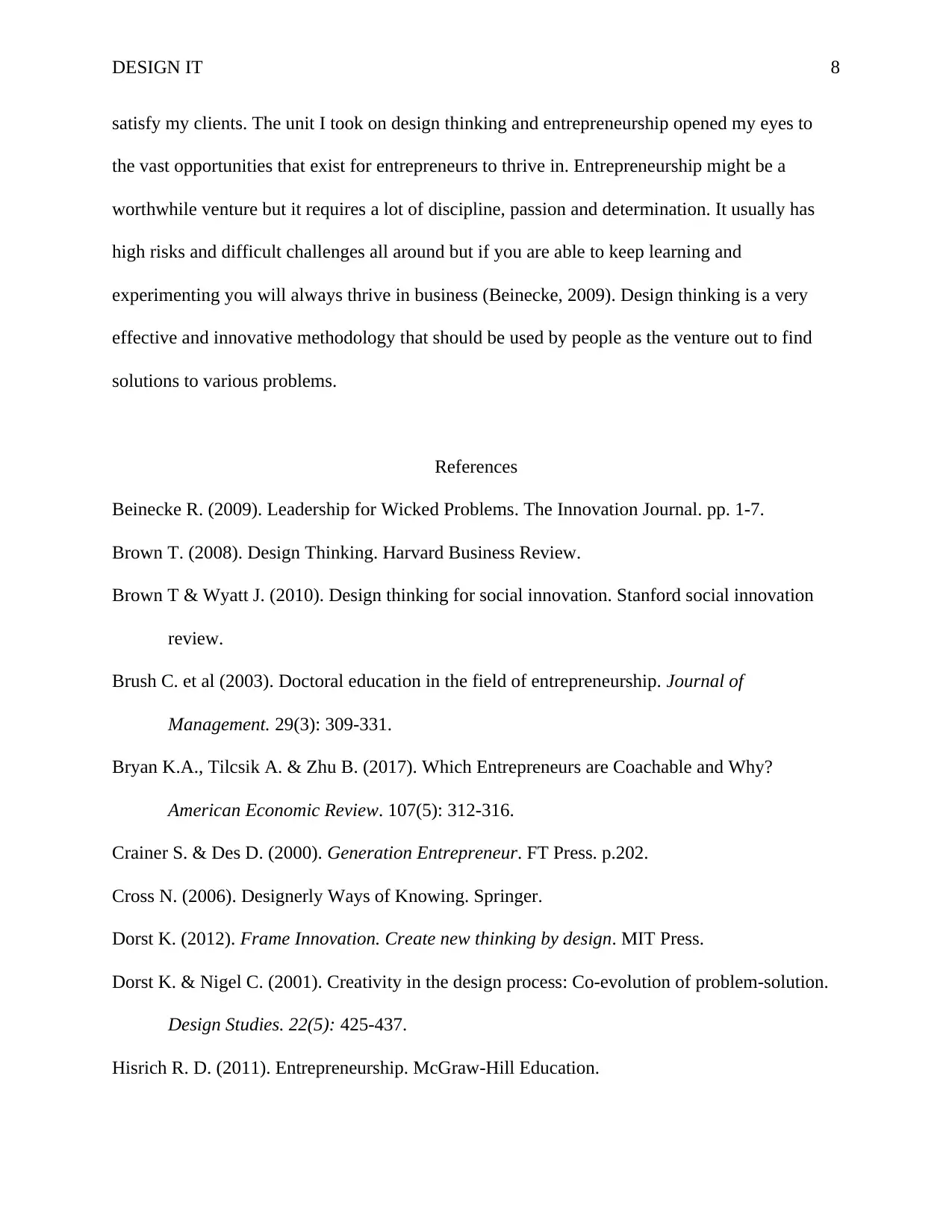
DESIGN IT 8
satisfy my clients. The unit I took on design thinking and entrepreneurship opened my eyes to
the vast opportunities that exist for entrepreneurs to thrive in. Entrepreneurship might be a
worthwhile venture but it requires a lot of discipline, passion and determination. It usually has
high risks and difficult challenges all around but if you are able to keep learning and
experimenting you will always thrive in business (Beinecke, 2009). Design thinking is a very
effective and innovative methodology that should be used by people as the venture out to find
solutions to various problems.
References
Beinecke R. (2009). Leadership for Wicked Problems. The Innovation Journal. pp. 1-7.
Brown T. (2008). Design Thinking. Harvard Business Review.
Brown T & Wyatt J. (2010). Design thinking for social innovation. Stanford social innovation
review.
Brush C. et al (2003). Doctoral education in the field of entrepreneurship. Journal of
Management. 29(3): 309-331.
Bryan K.A., Tilcsik A. & Zhu B. (2017). Which Entrepreneurs are Coachable and Why?
American Economic Review. 107(5): 312-316.
Crainer S. & Des D. (2000). Generation Entrepreneur. FT Press. p.202.
Cross N. (2006). Designerly Ways of Knowing. Springer.
Dorst K. (2012). Frame Innovation. Create new thinking by design. MIT Press.
Dorst K. & Nigel C. (2001). Creativity in the design process: Co-evolution of problem-solution.
Design Studies. 22(5): 425-437.
Hisrich R. D. (2011). Entrepreneurship. McGraw-Hill Education.
satisfy my clients. The unit I took on design thinking and entrepreneurship opened my eyes to
the vast opportunities that exist for entrepreneurs to thrive in. Entrepreneurship might be a
worthwhile venture but it requires a lot of discipline, passion and determination. It usually has
high risks and difficult challenges all around but if you are able to keep learning and
experimenting you will always thrive in business (Beinecke, 2009). Design thinking is a very
effective and innovative methodology that should be used by people as the venture out to find
solutions to various problems.
References
Beinecke R. (2009). Leadership for Wicked Problems. The Innovation Journal. pp. 1-7.
Brown T. (2008). Design Thinking. Harvard Business Review.
Brown T & Wyatt J. (2010). Design thinking for social innovation. Stanford social innovation
review.
Brush C. et al (2003). Doctoral education in the field of entrepreneurship. Journal of
Management. 29(3): 309-331.
Bryan K.A., Tilcsik A. & Zhu B. (2017). Which Entrepreneurs are Coachable and Why?
American Economic Review. 107(5): 312-316.
Crainer S. & Des D. (2000). Generation Entrepreneur. FT Press. p.202.
Cross N. (2006). Designerly Ways of Knowing. Springer.
Dorst K. (2012). Frame Innovation. Create new thinking by design. MIT Press.
Dorst K. & Nigel C. (2001). Creativity in the design process: Co-evolution of problem-solution.
Design Studies. 22(5): 425-437.
Hisrich R. D. (2011). Entrepreneurship. McGraw-Hill Education.
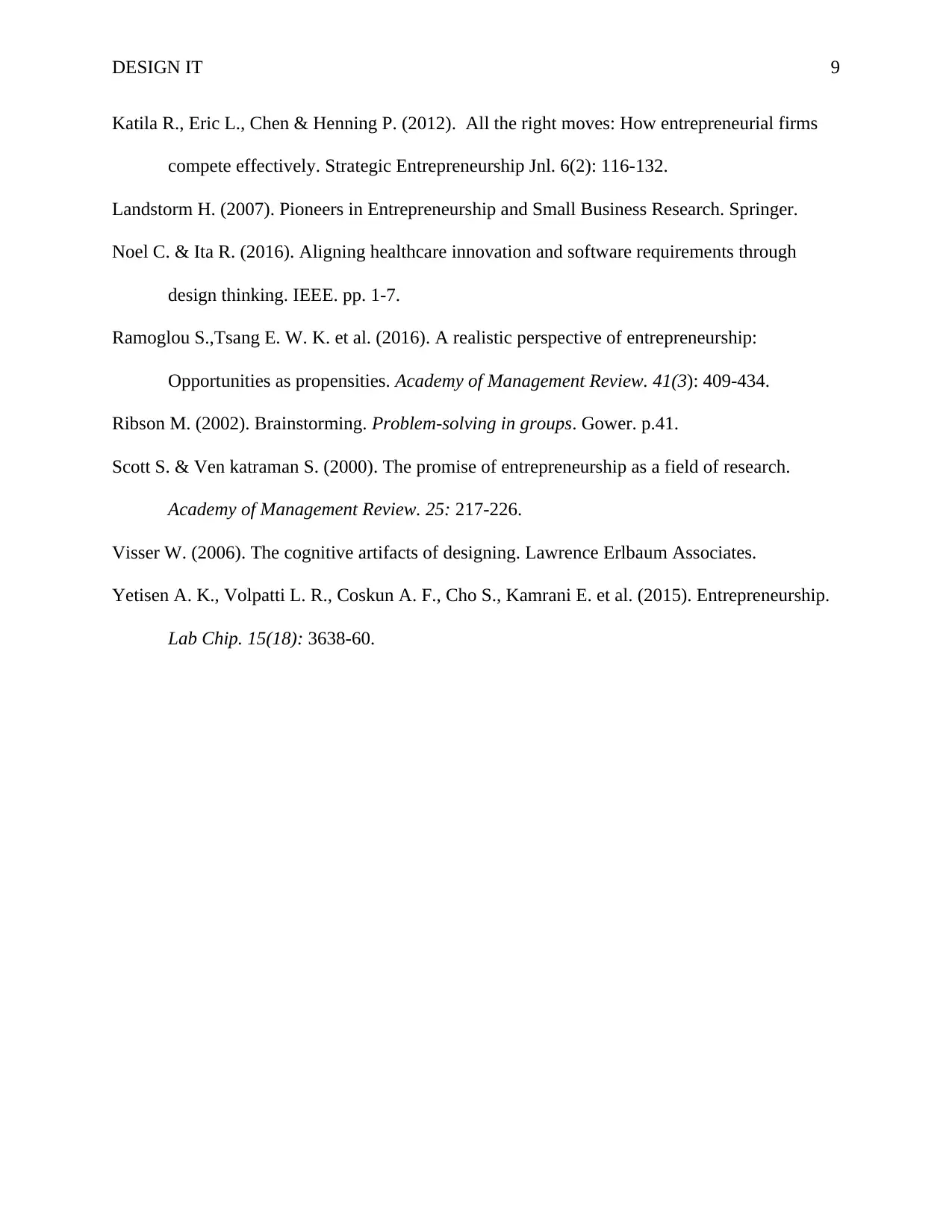
DESIGN IT 9
Katila R., Eric L., Chen & Henning P. (2012). All the right moves: How entrepreneurial firms
compete effectively. Strategic Entrepreneurship Jnl. 6(2): 116-132.
Landstorm H. (2007). Pioneers in Entrepreneurship and Small Business Research. Springer.
Noel C. & Ita R. (2016). Aligning healthcare innovation and software requirements through
design thinking. IEEE. pp. 1-7.
Ramoglou S.,Tsang E. W. K. et al. (2016). A realistic perspective of entrepreneurship:
Opportunities as propensities. Academy of Management Review. 41(3): 409-434.
Ribson M. (2002). Brainstorming. Problem-solving in groups. Gower. p.41.
Scott S. & Ven katraman S. (2000). The promise of entrepreneurship as a field of research.
Academy of Management Review. 25: 217-226.
Visser W. (2006). The cognitive artifacts of designing. Lawrence Erlbaum Associates.
Yetisen A. K., Volpatti L. R., Coskun A. F., Cho S., Kamrani E. et al. (2015). Entrepreneurship.
Lab Chip. 15(18): 3638-60.
Katila R., Eric L., Chen & Henning P. (2012). All the right moves: How entrepreneurial firms
compete effectively. Strategic Entrepreneurship Jnl. 6(2): 116-132.
Landstorm H. (2007). Pioneers in Entrepreneurship and Small Business Research. Springer.
Noel C. & Ita R. (2016). Aligning healthcare innovation and software requirements through
design thinking. IEEE. pp. 1-7.
Ramoglou S.,Tsang E. W. K. et al. (2016). A realistic perspective of entrepreneurship:
Opportunities as propensities. Academy of Management Review. 41(3): 409-434.
Ribson M. (2002). Brainstorming. Problem-solving in groups. Gower. p.41.
Scott S. & Ven katraman S. (2000). The promise of entrepreneurship as a field of research.
Academy of Management Review. 25: 217-226.
Visser W. (2006). The cognitive artifacts of designing. Lawrence Erlbaum Associates.
Yetisen A. K., Volpatti L. R., Coskun A. F., Cho S., Kamrani E. et al. (2015). Entrepreneurship.
Lab Chip. 15(18): 3638-60.
⊘ This is a preview!⊘
Do you want full access?
Subscribe today to unlock all pages.

Trusted by 1+ million students worldwide

DESIGN IT 10
1 out of 10
Related Documents
Your All-in-One AI-Powered Toolkit for Academic Success.
+13062052269
info@desklib.com
Available 24*7 on WhatsApp / Email
![[object Object]](/_next/static/media/star-bottom.7253800d.svg)
Unlock your academic potential
Copyright © 2020–2025 A2Z Services. All Rights Reserved. Developed and managed by ZUCOL.




